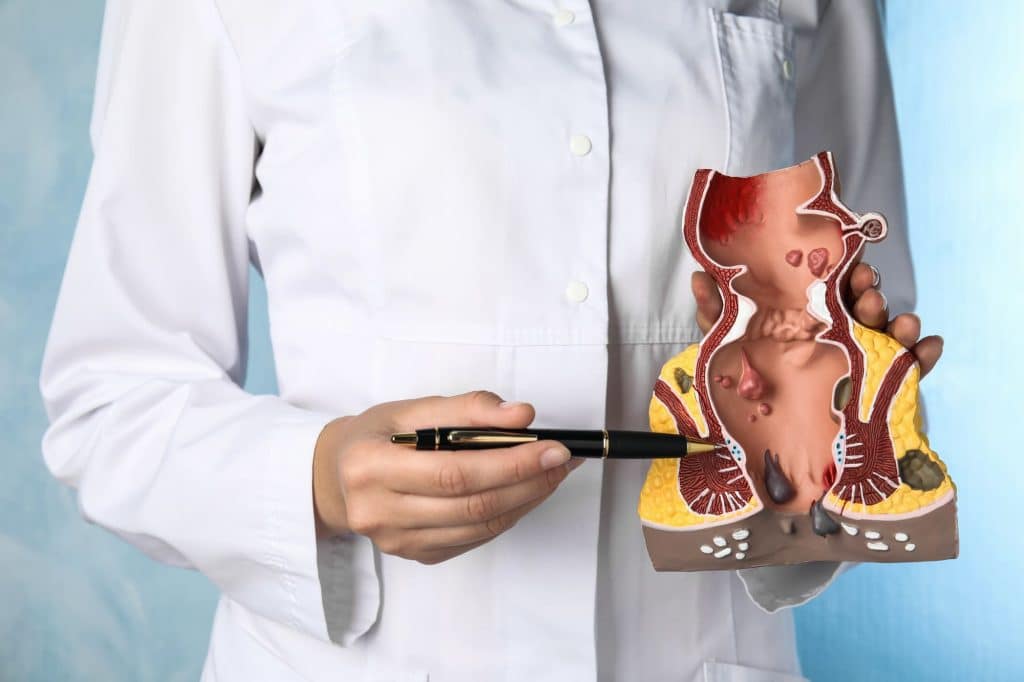What are Hemorrhoids?
Hemorrhoids are normal venous cushions found inside and outside the anus. We’re all born with them—typically three internal and three external. External hemorrhoids lie under skin rich in nerve endings, while internal ones are under mucosa with little sensation, making their symptoms and treatments very different.
Though the exact function of hemorrhoids is unclear, they may help maintain continence. When blood flow is restricted, hemorrhoids can swell and cause discomfort. While hemorrhoids do not cause cancer, getting your symptoms checked out can aid in early detection and prevention.
The pain from hemorrhoids is unique, but patients often confuse it with other conditions, like anal fissures. These two conditions have distinct physical sensations: internal hemorrhoids cause a pulsating or aching pain, while anal fissures cause a sharper, stinging pain on the skin surface.
Hemorrhoid banding, often called rubber band ligation or hemorrhoid ligation, can reduce the discomfort and bleeding from internal hemorrhoids. Hemorrhoid banding is an effective and painless treatment limited to specific patient cases.

What is Hemorrhoid Banding?
Hemorrhoid banding is a less-invasive, in office, alternative therapy to traditional hemorrhoid surgery. Rubber band ligation is only for internal hemorrhoids. Banding may be recommended if your internal hemorrhoid symptoms, like bleeding, prolapse, discomfort, do not respond to conservative natural therapies or hemorrhoid sclerotherapy.
Banding hemorrhoids is an uncomfortable but tolerable and straightforward procedure that involves placing a rubber band around the base of the internal hemorrhoid. It is done in the office without anesthesia, and patients can drive themselves to and from the appointment. The band constricts a portion of the hemorrhoid, which then causes it to wither and fall off.
How to Prepare for Hemorrhoid Banding
If your doctor has recommended banding your hemorrhoids, they will walk you through the procedure steps to ensure you understand the process. They will ask if you are taking any current medications, including over-the-counter medication, Aspirin products or nonsteroidal anti-inflammatory agents (NSAIDs), blood thinners like Plavix, Brilinta, Eliquis, Coumadin, Effient, or supplements. Due to the increased risk of bleeding when taking these medications, the doctor will ask you to stop taking them for a week before the rubber band ligation. Patients on Brilinta or Plavix must confirm with their prescribing doctor that it is safe to be off them for up to two weeks.
What to Expect During Hemorrhoid Banding
At Thousand Oaks Proctology, hemorrhoids are treated with only one band at a time, as multiple banding can be painful. I’ve found that the most effective method for treating more minor hemorrhoids is a dual approach. I first shrink the smaller hemorrhoids with sclerotherapy, and then I band the largest internal hemorrhoid.
To begin, I inspect the outside of the anus and perform a digital rectal examination to look for any abnormalities. This approach also helps relax the sphincter muscles. I insert a lubricated anoscope, which I use to evaluate the internal hemorrhoids.
I first treat the smaller hemorrhoids, then shift my focus to the larger ones. I place a suction litigator, the instrument used to insert the rubber band around the base of the internal hemorrhoid, into the anoscope. After suctioning a portion of the internal hemorrhoid into the ligator, I ask the patient if they are experiencing any pain. If the answer is no, I release the rubber band over the internal hemorrhoid. Once I place the band, I remove the anoscope and use my finger to feel the placement of the rubber band.

Aftercare for Banding Hemorrhoids
Slight discomfort post-operation is normal, even expected, and can be eased with over-the-counter medications. Maintaining regular bowel movements following rubber band ligation is very important. Passing large, long, soft bowels is like physical therapy to the anus, so don’t resist a bowel movement, although don’t push too hard, and consume a high-fiber diet before and after your hemorrhoid disbandment.
Other recovery tips for post-hemorrhoid banding include:
- Eat and drink for proctology health. I strongly suggest adding PERFECT P.O.O.P. raw psyllium fiber to drinks and taking laxative supplements, like psyllium, every day. These supplements help reduce hemorrhoid symptoms and recurrences.
- Soak in sitz baths. Sitz baths are warm, shallow baths filled with Epsom salts. I recommend patients sit in the water up to their hips when recovering from a hemorrhoid banding or surgery. Taking a sitz bath one to two times a day, or after every bowel movement, will help relieve any pain in the area.
- Avoid Heavy Lifting. Any lifting or straining, both in the bathroom and out, will cause unnecessary stress to the hemorrhoids. Although hemorrhoid banding is a simple procedure, bodies take time to heal.
- Avoid Toilet Paper. As you heal, avoid using toilet paper for wiping. Toilet paper can irritate the anus and cause itching and discomfort. Instead, try medicated wipes, baby wipes, or just water and soap to clean the area.
Side Effects of Hemorrhoid Banding
After a hemorrhoid banding procedure, you may notice some side effects as the hemorrhoids dry up and fall off. Hemorrhoid banding minor side effects may include:
- Bloating or swelling in the abdomen with slight pain
- Constipation
- Occasional bleeding in the first day or two following the procedure
Risks of Rubber Band Ligation
There are risks to rubber band ligation, and although they’re not frequent, they can occur. These risks include:
Severe infection: If you have excessive pain, a fever of 100.8 Fahrenheit or greater, or can not urinate, you likely have a serious infection and need to call your doctor immediately. Patients need to be in town for two weeks post-procedure in case of complications.
Severe bleeding that does not stop:If you experience more than a coffee cup’s worth of blood, call your doctor.
While hemorrhoids are the usual culprits behind bleeding or rectal pain, they also have similar symptoms to colon and rectal cancer. Erring on the side of caution when it comes to getting that hemorrhoid checked out can be life-saving as your proctologist may find, detect, and remove pre-cancerous polyps.

Alternatives to Hemorrhoid Banding
Although banding hemorrhoids is one of the preferred methods for removing internal hemorrhoids, your doctor may suggest other procedures, including surgery, depending on their exam.
Sclerotherapy
Sclerotherapy is a common procedure used to treat internal hemorrhoids. A doctor injects a chemical into the hemorrhoid, which cuts off the blood flow to it, allowing the hemorrhoids to wither and fall off.
Sclerotherapy is my first line of therapy as it is painless, effective, and treats multiple internal hemorrhoids at the same time. If sclerotherapy fails to work for six months or longer, or the patient wants a more permanent result, I perform rubber band ligation on the largest internal hemorrhoid.
Cryotherapy
Cryosurgery involves freezing internal hemorrhoids with a cryoprobe and either nitrous oxide or liquid nitrogen. Due to its ineffectiveness and the issue of leaving a weeping wound, this therapy has been abandoned.
Infrared coagulation therapy
Infrared coagulation therapy uses heat to cut off the blood supply to a hemorrhoid. A doctor will use a power beam of infrared light to heat the hemorrhoid. The process can take anywhere from thirty seconds to a few minutes, depending on the size of the hemorrhoid. In my experience, sclerotherapy is far superior and less expensive than infrared coagulation therapy.
Traditional surgery
In my practice, hemorrhoid surgery is not usually recommended unless the patient has internal hemorrhoid symptoms that fail conservative therapy. Although hemorrhoid surgery involves a longer recovery time (10–14 days) the majority of patients who undergo the procedure are very satisfied with the results. Also with the use of Exparel, a shot to numb the area for 2-4 days, the post operative recovery is much better.
Surgery is done at an outpatient center with anesthesia. While the patient is asleep, the surgeon will excise the internal and external hemorrhoids and suture the wound to prevent bleeding.
I perform surgery in only 10-20% of hemorrhoid cases because conservative therapies, like adding PERFECT P.O.O.P. raw psyllium fiber, all-natural hemorrhoid-shrinking antioxidants like Diosmin/Hesperidin (R.H.O.I.D. – AID), and office-based therapy works well to alleviate the symptoms for long periods.

Hemorrhoid Banding FAQ
How painful is banding hemorrhoids?
As a general rule, it shouldn’t hurt to have a band placed around your hemorrhoid, though we all have different pain thresholds. After the procedure, you may experience some deep aching and discomfort, which often settles into a dull ache lasting for about five hours or up to the next morning. The feeling is similar to needing to poop.
How long does banding hemorrhoids take?
Banding hemorrhoids is a relatively simple procedure that usually takes up to five minutes. While the procedure is straightforward and you can return home afterward, avoid booking plans for up to two weeks after the procedure, as the discomfort will most likely prevent you from attending them and the bleeding risk can happen around day ten. It is best to go home, relax, and have a packet of Tylenol ready.
It doesn’t take long for the hemorrhoids to fall off after banding. After the band is placed, the internal hemorrhoid will wither and fall off in about 2-3 days. Once the band falls off, the wound forms an ulcer, which heals over 3-4 weeks. The scar tissue that forms contracts and shrinks the hemorrhoids even more, which holds the remaining hemorrhoid in place.
How much does banding hemorrhoids cost?
Hemorrhoid treatment is generally covered by insurance. For pricing, call our office at 805 230-2889 or contact us.
How effective is banding for hemorrhoids?
Banding hemorrhoids have a high success rate of 70% and 97%, but how long banding hemorrhoids last depends on the hemorrhoid grade, the banding technique used, aftercare, and whether the patient requires multiple treatments. Banding hemorrhoids is not considered a permanent cure. It lasts 3-5 years on average.
Banding for hemorrhoids does not work for external hemorrhoids located below the dentate line, where nerve endings make the procedure too painful. Hemorrhoid banding may also be less effective for grade 4 hemorrhoids, the most severe type, which have permanently prolapsed. In some cases, hemorrhoids that don’t shrink away on their own may also require surgery.
Is Hemorrhoid Banding Right for You?
Only a proctologist can determine whether hemorrhoid banding is right for you. If you suspect you have internal hemorrhoid symptoms or notice bright red bleeding, pressure, the urgency to have a bowel movement, or mucous discharge, it is best to see a proctologist.
Think of a proctology appointment as a two-for-one deal. Several other conditions can cause the same symptoms as hemorrhoids or an anal fissure, including serious ones, so an appointment may catch other conditions–like colon polyps– you might not have been aware of.
If you’re dealing with hemorrhoid symptoms or need expert advice on hemorrhoid banding, don’t wait, book a consultation with Thousand Oaks Proctology today. We can help you get to the bottom of your problems. Contact us to schedule your appointment!

